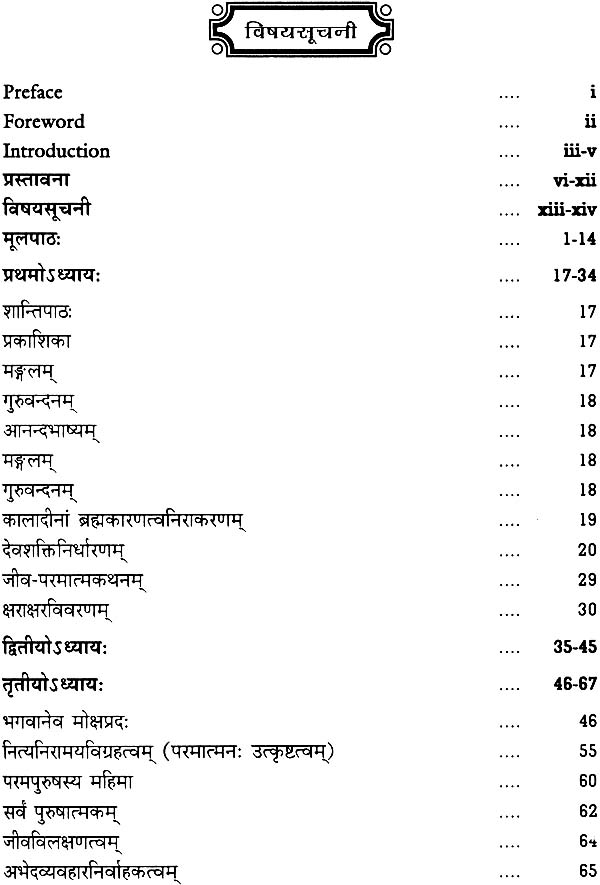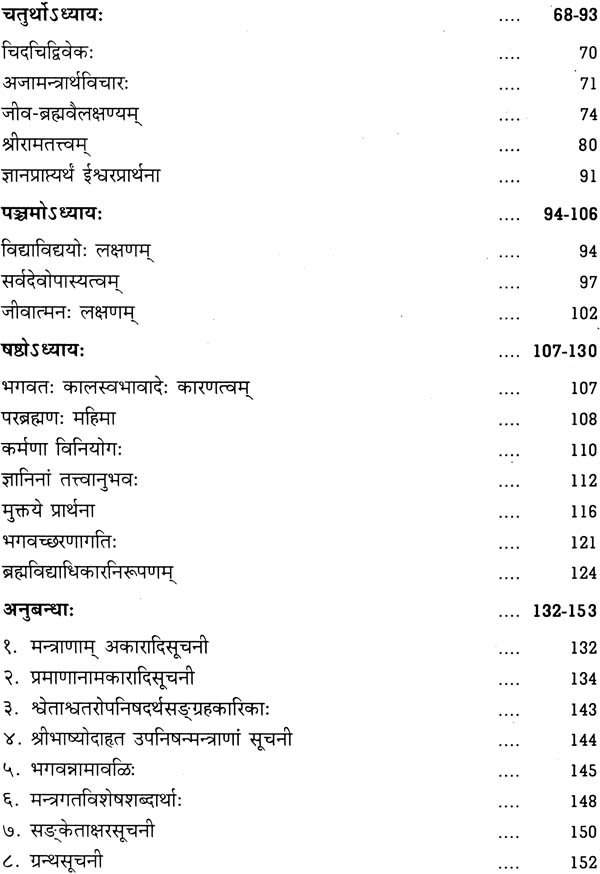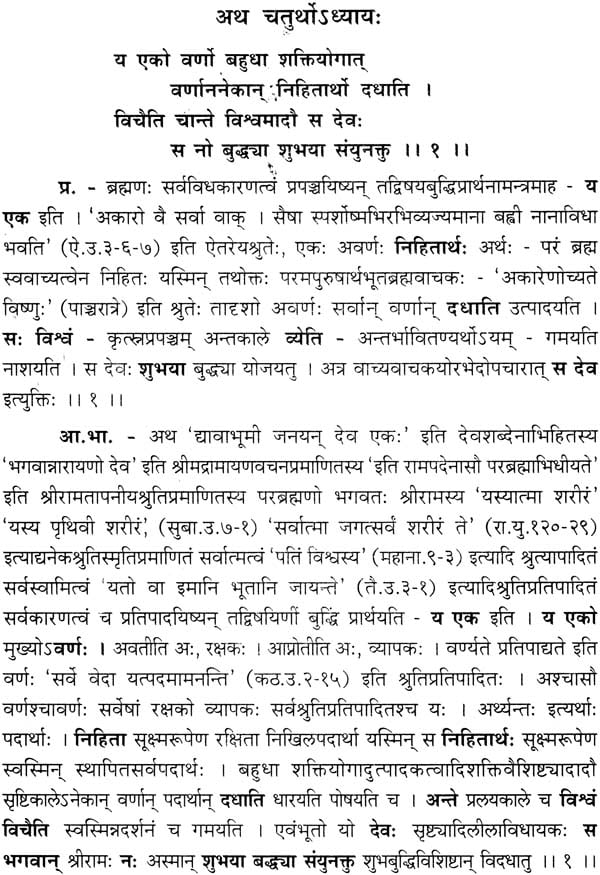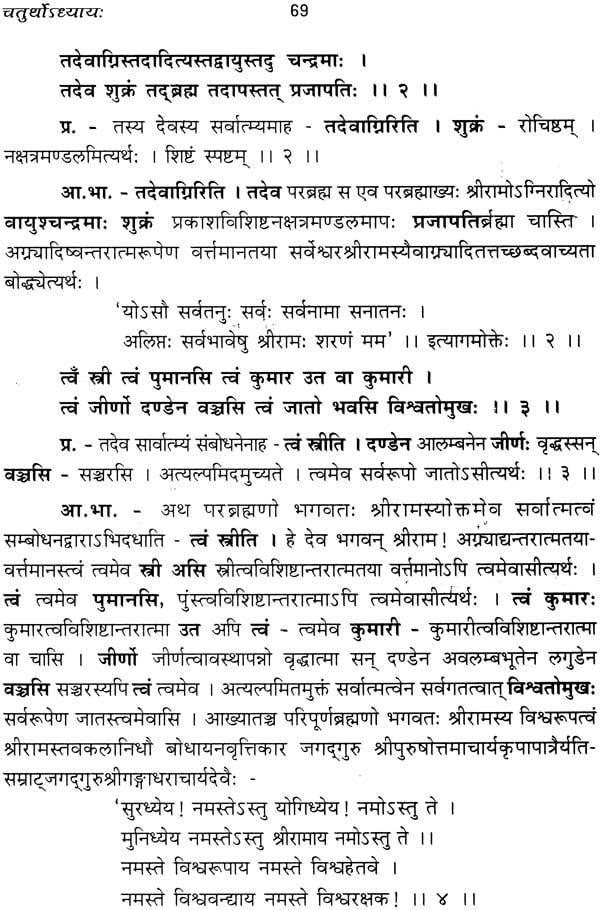श्वेताश्वतरोपनिषत्: Shwetashvatara Upanishad with Commentary of Ranga Ramanuja (Critical Edition)
Book Specification
| Item Code: | NZF935 |
| Author: | श्री एस. कुमार (Shri S. Kumar) |
| Publisher: | Academy of Sanskrit Research, Melkote |
| Language: | Sanskrit Only |
| Edition: | 2012 |
| ISBN: | 9789380900193 |
| Pages: | 174 |
| Cover: | Paperback |
| Other Details | 9.5 inch X 7.0 inch |
| Weight | 340 gm |
Book Description
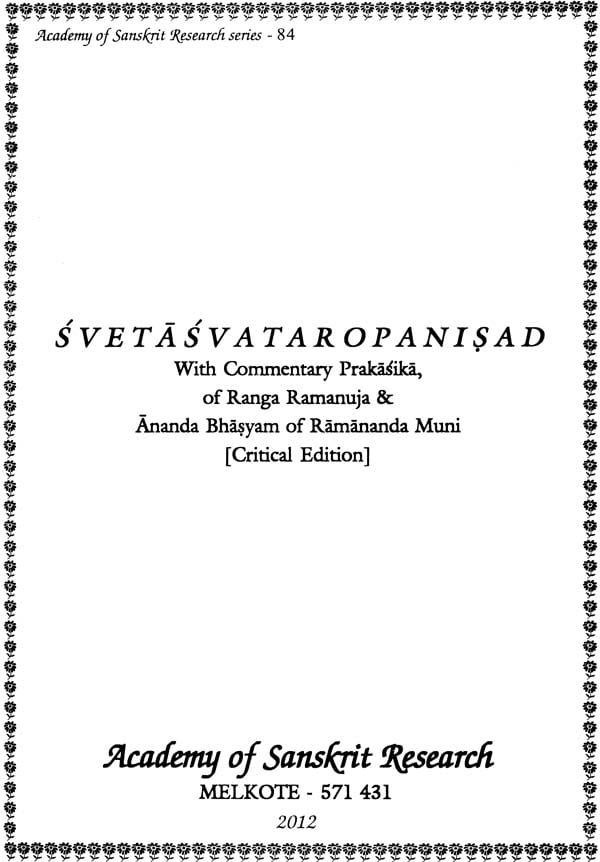
We are delighted to bring out another critical edition of Upanisad namely ‘Svetasvataropanisad’ in its series. As we are aware of what is Upanisad and how it is held in high esteem not only by Indians but by many all over the world gives us pride. Upanisad as body of literature has been an enlightening device to mankind from time immemorial. The stories, narratives and episodes occurring therein have timeless values for humanity. It is the universal message in it for the man on lasting principles has been appreciated by modern thinkers even.
The Academy of Sanskrit Research as having published critical editions of other major Upanisads, it is time to bring forth minor ones. It is also a thing of satisfaction for the institution to be engaging constantly in the endeavor of publishing books of real value. It is also being proposed to publish simple translations of all these monumental works in Kannada and English. We acknowledge one and all for their sincere efforts in making this publication come out nicely. We wish our earnest readers to make use of the worth in the book.
The Academy of Sanskrit Research, Melkote since its inception in 1977 has continuously been engaging in various academic activities by way of conducting seminars, workshops and conferences at state as well as national levels. This apart, another major activity concerns this institute is that of research and publication of ancient books of eternal value. Thus it has brought out critical editions, research journals, a book on ancient science and technology.
In its Upanisad series it has already brought out all principle Upanisads with valuable commentaries conforming to the school of Bhagavad Ramanuja. It has longer objective of publishing all monumental works in respect of tradition, heritage as well as on ancient science in the long run.
We are happy to offer our readers the edition of ‘Svetasvataropanisad’. This Upanisad though of later time has essential nature and characteristic of major Upanisad. Two commentaries are presented in line with tenets of Ramanuja should make for better reading and grasp of the original. We hope true seekers of knowledge will be largely benefited by this worthwhile endeavor. We extend our heartfelt gratitude to all those involved directly or otherwise in the task of publication.
It is the utmost sanctity attached to the words of seers, sages and great teachers that make them gospel of eternal truth. For these divine personalities neither their utterance meant to be a fashionable exercise nor a show of exuberance but a wakeup call for mankind to get up from its slumber of ignorance. Ecstatic statements, elaborative descriptions, precise parables and amazing figures of speech have been employed by them in order to make us aware of the eternally immutable principle governing this cosmic creation.
In our keen observation of life of divine preceptors, we invariably come across instances of mystical hue occurring in their life, where by they are chosen as channels of Revelation. Yet this selection would come unbidden, bestowing them with a transcendental vision where the secret of the universe and the riddle of existence become unraveled. It is their steadfast approach, undivided attention, unflinching devotion and unrelenting trail in pursuit of Supreme Truth in making them accomplished and elevated to realm of ecstasy.
Upanisads thus are the treasure- troves of wise thoughts on eternity of great sages, seers, as well as of divine preceptors. Their words issued forth from such a higher plane of intellectual living that a seeker at the beginning finds them mere abstract imageries. The intrinsic philosophic worth that they hold would only be cherished with an enduring earnest. Hence we find line of facilitative teachers guiding their pursuant pupil closely to grasp esoteric sense of the terms that they employ in these texts. Upanisads aptly termed as ‘Vedanta’ forming the cream of the Vedas with crystallized ideas of truth set in the language of formulae.
‘Svetasvataropanisad’ belonging to Krishnayajurveda branch has six chapters and 113 Mantras or hymns. Though not appearing in the list of major or principal Upanisads, it has been often quoted by great masters like Shankara and Ramanuja. Another scholastic view suggests that this Upanisad might have been a later addition in respect of its compositional period vis-e-vis other Upanisads. Nonetheless its importance as well as authority never pale into insignificance being late.
This Upanisad derives its name from sage Svetasvatara’ who happens to teach Sanyasins (Monks of the highest order) the knowledge of the Supreme Brahman. This has been referred in the twenty-first stanza of sixth chapter. An honorific significance attached to the name of the sage can be known by derivation of the title 'श्वेता अवदाता अश्वा इन्द्रियाणि यस्य स श्वेताश्व: | अतिशयेन श्वेताश्व: श्वेताश्वतर:' | indicating that ‘he who had his sense organs very pure.
Saint-philosopher-teacher of great renown Ramanuja who promulgated the school of qualified monism popularly known as ‘Visistadvaita’ quotes from this Upanisad in his exposition. He considers this Upanisad as a whole offers a cordial climate to his thought.
It may be the elucidation of intrinsic qualities of Supreme God or glories of lswara or its professing of ‘Jiva’ as distinguished from lswara, all this and that offer valid philosophic stance to Ramanuja. Thereupon he resorts to this Upanisad as and when it is required of him to. provide clear instances of Bheda-sruti, scriptural texts differentiating the individual self from Brahman. Ramanuja in his Sribhasya under Chamasadhikarana 1-4-2-8 while refuting the Sankhyan view of Prakrti being independent of Brahman, profusely quotes from this Upanisad. By supplying several references from this Upanisad it is asserted here that Prakrti as an entity cannot be independent of Brahman.
As the Supreme Brahman being the indwelling principle in manifest and un-manifest there cannot be an independent existence for both.
This Upanisad is again referred to in Paradhikarana 3-2-7-35&36 while establishing the supremacy of Parama-purusha, over and above all principles. It is the Supreme Brahman which is both the casual as well as material cause of creation beyond which there cannot be a governing principle. There is a stanza in this Upanisad 1-12 that seemingly propounds three realities and three modes of meditation on Brahman which is pluralistic in view. The three realities namely Bhoktr, Bhogya and Preritr are corresponding to the enjoyer which is Jiva or the Individual self, the enjoyed being the material world, and lswara or the Supreme god being the impeller who actuates other two entities. The individual self while finds his pleasures and pains in the material world; he invariably gets entangled in Samsara thus going through the course of transmigratory existence. By knowledge of the Supreme god or lswara he transcends his body and attains perfection. Ramanuja in his exegetical treatment of the above refers to the Brahman as three-fold thus positing an inseparable relation among three realities in Vedarthasamgraha, The three-fold presentation of Brahman with its nature and attributes paves way for three- fold meditation on Brahman which being the indwelling principle in all. Thus the apparent pluralism is negated.
Another sublime theistic philosophy that Ramanuja finds here is explicit expressions of ‘Saranamaham prapadye’ and ‘Parabhakti’ occurring in eighteenth and twenty-third stanzas of sixth chapter. These very words unequivocally set forth the pathway of surrender and utter devotion to the god. The aspect of Bhakti being highly appreciated in later treatises is a notable proposition here.
Ramanuja finds an apt and harmonious thought running through this text for his elucidation of Monistic theism. At the same time the concept of Antaryami or indwelling aspect of Supreme Brahman is too being brought out beautifully here for him. This Upanisad thus can be regarded as an earlier devotional poetry of excellence.
This edition is presented with two useful commentaries ‘Prakasika’ of Rangaramanujamuni and ‘Anadabhasya’ of Rangaramanujamuni. Both commentaries truly follow the spirit of Ramanuja philosophy and bring in essential value to the origin. Rangaramanujamuni was an ascetic-scholar of great repute, who has to his credit more than sixty works, among them his commentaries to Upanisads standout as versatile with their simplicity. These commentaries show their fidelity to the school of ‘Visistadvaita’ by following the words of Ramanuja and Desika, He is said to have flourished in 17th century leading a virtuous life. Another pious personality is Ramanandamuni who lived in 13A.D. He had extensively traveled north of India having propagated tenets of Ramanuja, thus contributing greatly to Srivaisnava tradition in those regions. His commentaries to Upanisads in light of Visistadvaita are lucid, detailed and striking.
